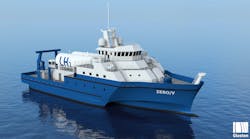A hydrogen-powered research vessel has never been studied or proven—until now. Sandia National Labs engineers recently showed that it is technically and economically feasible to build such a vessel that would be consistent with marine regulations. The project team nicknamed the vessel the “Zero-V,” short for zero-emissions research vessel.
One of the biggest benefits of using hydrogen to power a ship is the absence of ecologically damaging fuel spills. According to Sandia scientist Lennie Klebanoff, it is impossible to have a polluting hydrogen spill on the water. More buoyant than helium, hydrogen rises on its own and eventually escapes into outer space.
Fuel cells even generate water so pure that the ship’s crew can drink it (with conditioning), or use it for scientific experiments; this reduces the need to desalinate seawater, which currently consumes large amounts of energy. Fuel cells are also electrical devices and, as such, offer a faster power response than internal combustion engines.
The Zero-V project evolved from earlier Sandia work on the SF-BREEZE, a hydrogen-powered passenger ferry designed to operate in the San Francisco Bay. Small hydrogen-powered pleasure crafts suitable only for short distances already existed. But prior to the SF-BREEZE, a maritime project had never examined the technical and economic feasibility of powering large, fast commercial boats with hydrogen.
The entire plan, including ship design, weight distribution, and refueling options, had to be re-evaluated for the Zero-V. “Instead of going fast for short periods and carrying a lot of people, the research vessel goes slower for much longer distances, carries fewer people, and must allow the operation of sensitive scientific instrumentation,” Klebanoff explains.
While working on the SF-BREEZE, Klebanoff approached the Scripps Institution of Oceanography to see whether researchers there were interested in a hydrogen-powered vessel. They were, if it could complete tasks considered routine for such ships, such as marine ecosystem studies, physical oceanography, and tsunami risk and ocean chemistry research.
Mapping or installing equipment on the ocean floor requires a vessel that is stable over a single point for long periods despite wind or waves. The team quickly determined the Zero-V could maintain its position in the face of 25-knot winds and waves from any direction if they installed propulsion devices on both sides of the hull.
Whereas the faster SF-BREEZE required refueling after only 100 miles, the Zero-V can go 2,400 miles or 15 days before requiring refueling. That’s enough range to sail from San Diego to Hawaii. Given the great distances it needs to travel, a refueling terminal in a single central location isn’t what is needed. The Sandia team found an innovative approach that lets liquid hydrogen suppliers drive fuel trucks directly to the ship at ports of call. Thus, the Zero-V would require little investment in fueling infrastructure.
Zero-V would also need to store onboard heavy hydrogen tanks while accommodating at least 18 scientists, 11 crew members, and three labs. To partially solve the overcrowding problem, the ship will use a trimaran design with three parallel hulls, typically used for high-speed boats. The design offers a great deal of space above deck for hydrogen tanks, in addition to adequate below-deck space for berthing and science instruments and machinery.
Having designed the Zero-V using proven, commercially available hydrogen technology, the team is confident of its success. Once completed, the vessel design was reviewed by DNV GL and the U.S. Coast Guard. Both regulatory bodies independently came to the same conclusion: There are no “show-stopping” technical issues with the Zero-V design.
In fact, DNV GL hydrogen expert Gerd Petra Haugom says the Zero-V design shows an essential understanding of the safety-related properties of hydrogen, and how it can be used safely and securely on a vessel. “This project has been a good test of our own rules and the alternative design approach for using hydrogen and fuel cells,” she said. “Results from the Zero-V will be part of a benchmark to guide our assessment of similar vessels in the future.”
With a solid design in place, the next step for the Zero-V is finding the funding to build it. Compared to diesel-powered research vessels, the Zero-V has a similar capital cost, but would cost roughly 7% more to operate and maintain. Given its benefits, less noise, zero emissions, and no risk of causing polluting fuel spills, it is hoped that donors will step up to support the project.
“Like other game-changing ideas, this approach initially seems expensive,” says Bruce Applegate, who oversees the Scripps fleet. “But solar power was expensive not too long ago, and now it’s affordable and widely adopted.
“Hydrogen fuel cells are just as transformative a technology,” he continues. “They produce clean, quiet, nonpolluting power to ships while enabling superior scientific capabilities. Building and operating the Zero-V will significantly advance U.S. marine transportation technology.”

